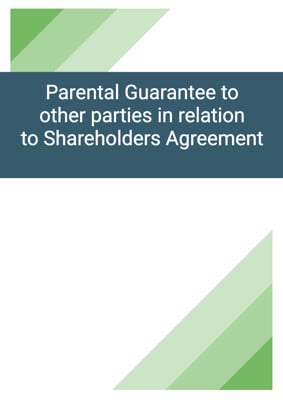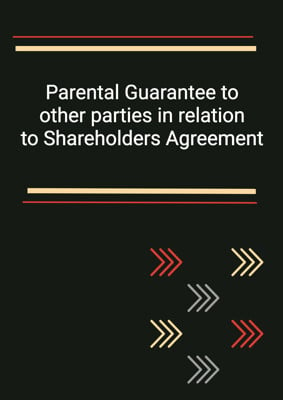How to Tailor the Document for Your Need?
01
Create Document
Fill in the details of the parties. You can click the "Fill with Member’s Information" button to complete it with information saved to your account.
02
Fill Information
Please fill in any additional information by following the step-by-step guide on the left hand side of the preview document and click the "Next" button.
03
Get Document
When you are done, click the "Get Document" button and you can download the document in Word or PDF format.
04
Review Document
Please get all parties to review the document carefully and make any final modifications to ensure that the details are correct before signing the document.
Document Preview
Document Description
This shareholders agreement is a legally binding document that governs the relations between the parties as shareholders in a jointly-owned company. The agreement highlights the importance of forming the company and establishes the terms and conditions that will guide the shareholders' relationship. The document consists of several sections, each addressing specific aspects of the shareholders' rights and obligations.
The first section of the agreement is the interpretation section, which provides definitions for key terms used throughout the document. These definitions include terms such as 'party 1 director,' 'party 1 shares,' 'party 2 director,' 'party 2 shares,' 'party 3 director,' 'party 3 shares,' 'board,' 'the business,' 'completion,' 'conditions precedent,' 'company,' 'member of the party 1 group,' 'member of the party 2 group,' 'member of the party 3 group,' 'memorandum and articles,' and 'parties.'
The second section of the agreement deals with the establishment of the company. It outlines the requirements for incorporating the company, including its name, authorized share capital, and registered office. The completion of the establishment of the company is also discussed, specifying the actions that need to be taken by each party to finalize the incorporation process. Additionally, the section mentions the execution of ancillary agreements related to asset transfer, distribution, technology license, intellectual property license, supply, services, and trade mark agreements.
The third section of the agreement focuses on the capital and further finance of the company. It states the share capital structure of the company, including the proportion of shares held by each party. The section also addresses the possibility of increasing the share capital and the procedures for providing further finance to the company.
The fourth section of the agreement covers the appointment and removal of directors and the management of the company. It establishes that the business and affairs of the company will be managed by a board of directors, with each party having the right to appoint and maintain directors. The section also outlines the quorum and voting requirements for board meetings, as well as the notice and agenda procedures.
The fifth section of the agreement deals with reserved shareholder matters. These are specific matters that require the prior approval of the parties, such as the issue of shares, sale of the company, alteration to the memorandum and articles, borrowing by the company, approval of the annual budget and operating plan, and appointment of auditors.
The sixth section of the agreement addresses the transfer of shares. It establishes the procedures for a party to sell or dispose of its shares, including the requirement to give a transfer notice to the other party. The section also covers the rights of the continuing party to purchase the shares and the determination of the fair price in case of disagreement.
The seventh section of the agreement focuses on confidentiality. It requires the parties to keep confidential any information they acquire in relation to the company or the other party and not to use or disclose such information without consent, except in certain specified circumstances.
The eighth section of the agreement imposes restrictions on the parties from engaging in any competing business during the term of the agreement.
The ninth section of the agreement establishes the term of the agreement and the notice period for termination. It also addresses the liquidation of the company upon termination.
The tenth section of the agreement emphasizes the supremacy of the agreement over the memorandum and articles of the company.
The eleventh section of the agreement states that the costs of incorporation will be borne by the company, and each party will pay its own costs related to the preparation and execution of the agreement.
The twelfth section of the agreement clarifies that the agreement does not create a partnership or agency relationship between the parties.
The thirteenth section of the agreement confirms that the agreement, along with any other agreements entered into on completion, constitutes the entire agreement between the parties and supersedes any previous representations or warranties.
The fourteenth section of the agreement prohibits the parties from assigning their rights or obligations under the agreement without the consent of the other party.
The fifteenth section of the agreement, if applicable, outlines the conditions precedent to the establishment of the company and the consequences if these conditions are not fulfilled.
The sixteenth section of the agreement states that any variation of the agreement must be in writing and signed by the parties.
The seventeenth section of the agreement clarifies that the agreement does not confer any rights on third parties to enforce its terms.
The eighteenth section of the agreement provides for the resolution of disputes through negotiation and mediation.
The nineteenth section of the agreement specifies the procedures for giving notices under the agreement, including the methods of service and the addresses of the parties.
The twentieth section of the agreement contains the signatures of the authorized representatives of the parties, indicating their agreement to the terms and conditions outlined in the document.
Overall, this shareholders agreement is a comprehensive and detailed document that covers all aspects of the shareholders' relationship and the governance of the company.
How to use this document?
To use this shareholders agreement effectively, follow these steps:
1. Familiarize yourself with the entire agreement: Read the agreement carefully to understand its provisions and the rights and obligations of the parties involved.
2. Establish the company: Follow the procedures outlined in Section 2 to incorporate the company, including choosing a name, preparing the memorandum and articles, and issuing shares to each party.
3. Determine the share capital: Understand the share capital structure of the company as described in Section 3. Take note of the proportion of shares held by each party and the possibility of increasing the share capital.
4. Appoint directors: Follow the procedures in Section 4 to appoint directors to the board. Ensure that each party exercises its right to appoint and maintain directors in accordance with the agreement.
5. Manage the company: Understand the responsibilities and decision-making authority of the board as outlined in Section 4. Ensure that board meetings are properly conducted, with the required quorum and voting procedures.
6. Obtain approval for reserved shareholder matters: Any matters listed in Section 5 that require the approval of the parties must be discussed and agreed upon. Follow the procedures for obtaining approval, either through written consent or unanimous resolution.
7. Handle share transfers: If a party wishes to sell or dispose of its shares, follow the procedures outlined in Section 6. Provide transfer notices and allow the continuing party the opportunity to purchase the shares at the specified price. If necessary, involve auditors to determine a fair price.
8. Maintain confidentiality: Adhere to the confidentiality obligations stated in Section 7. Keep any information related to the company or the other party confidential, unless permitted by the agreement or required by law.
9. Avoid competing business: Comply with the restrictions on engaging in competing business as stated in Section 8. Refrain from participating in any business that competes with the company during the term of the agreement.
10. Respect the term and notice period: Abide by the agreed term of the agreement and provide the required notice period for termination, as specified in Section 9. If termination occurs, cooperate in the liquidation process of the company.
11. Follow the agreement's supremacy: Ensure that the provisions of this agreement prevail over the memorandum and articles of the company, as stated in Section 10.
12. Handle costs: Understand the cost allocation mentioned in Section 11. The company will bear the costs of incorporation, while each party is responsible for its own costs related to the agreement.
13. Avoid partnership or agency relationships: Remember that the agreement does not create a partnership or agency between the parties, as stated in Section 12.
14. Consider the entire agreement: Acknowledge that the agreement, along with any other agreements entered into on completion, constitutes the entire agreement between the parties, as stated in Section 13.
15. Seek consent for assignment: Obtain consent from the other party before assigning any rights or obligations under the agreement, as stated in Section 14.
16. Fulfill conditions precedent (if applicable): If conditions precedent are specified in Section 15, ensure that they are fulfilled or waived before completion of the establishment of the company.
17. Seek written variations: Any variations to the agreement must be in writing and signed by the parties, as stated in Section 16.
18. Understand third-party rights: Note that the agreement does not confer any rights on third parties to enforce its terms, as stated in Section 17.
19. Resolve disputes amicably: In case of disputes, follow the dispute resolution procedures outlined in Section 18, which may involve negotiation and mediation.
20. Serve notices correctly: Use the specified methods of service and addresses provided in Section 19 for giving notices under the agreement.
By following these steps, you can effectively use this shareholders agreement to govern the relations between the parties and ensure compliance with the agreed-upon terms and conditions.


























